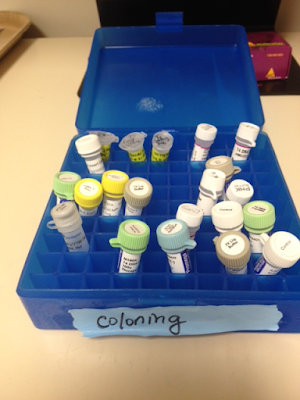When I last posted, nearly 3 weeks ago, my first attempt to generate the desired full-length knockout construct had given a mixture of fragments rather than just the desired full-length one. But this mixture did include a relatively faint fragment of the desired size (3.6 kb).
I did try to get a better PCR product, but increasing the annealing temperature made things worse, and I couldn't find a PCR app that would let me diagnose which incorrect-priming reactions were producing the unwanted fragments. So I went ahead and transformed competent
Actinobacillus pleuropneumoniae cells with the mixture, selecting for spectinomycin resistance.
My logic was that only the desired fragment is likely to efficiently transform cells to SpecR, because other fragments were unlikely to have the correct homologous DNAs flanking the SpecR cassette. If the 3.6 kb fragment was what I hoped it was, I should get thousands of transformants even though it was only about 10% of the total DNA in the mixture. If it wasn't what I wanted, then it would probably transform very inefficiently if at all and I would get very few transformants.
I got thousands of transformants in my first try. Since the real goal of this project is to find out whether knocking out the antitoxin gene prevents transformation in
A. pleuropneumoniae as it does in
H. influenzae, I did a quick-and-dirty competence assay, using 7 pooled SpecR colonies and some kanamycin-resistant
A. pleuropneumoniae chromosomal DNA. This gave lots of KanR transformants, but luckily I didn't take this as a final result.
Instead I went back and redid the transformation of
A. pleuropneumoniae with the PCR mixture, this time using a lot less DNA. I did this because the high DNA concentration used in the original transformation meant that many cells could have taken up multiple DNA fragments. In
H. influenzae such fragments are known to undergo ligation in the periplasm, allowing formation of chimeric recombinants that give very confusing results. Using 100-fold less DNA still gave plenty of SpecR transformants, and I streaked 4 of these to get clean single colonies. (Two of the picked colonies were large, and two were smaller, but all gave large colonies on their streak plates.)
I tested 2 of these colonies by PCR. Only one (14-1) gave the expected 3.6 kb full-length product and 1.1 kb Spec cassette products. The other (14-2) gave no product with the full-length primers and what looked to be a slightly small product with the Spec primers. The control wildtype cells gave the expected 2.6 kb full-length fragment and no Spec fragment.
At the same time I tested both colonies for the ability to be transformed. Both were defective, with transformation frequencies 100-fold lower than the wildtype cells. This is the most interesting result - it suggests that the Toxin-antitoxin system in
A. pleuropneumoniae plays the same role in competence as its homologue does in
H. influenzae.
Next steps: More comprehensive characterization of all the
A. pleuropneumoniae mutants. First do the full-length PCR on colonies 14-1, -2, -3 and -4, on the ∆toxin and ∆toxin/antitoxin mutants made by the honours student, and on the wildtype control, this time running the gel more slowly to better characterize the fragment lengths. Then do additional PCRs using other primers, to confirm the mutant structures, and repeat the competence assays on all these strains.
I'll also need to get all the final mutants sequenced, to confirm that they have only the expected deletions. I'll email the former RA to ask her the best way to do this (do I send genomic DNA or PCR products, what primers are best...).












































